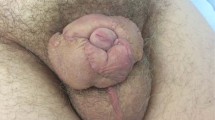Abstract
The effectiveness of topical steroid application in relieving phimosis was studied in 63 boys treated with local application of steroid ointment to the foreskin. Betamethasone valerate 0.05% (42 patients), hydrocortisone 1% (18 patients), or hydrocortisone 2% (3 patients) was applied three times daily for 4 weeks. Thirty-seven of the patients treated with 0.05% betamethasone valerate ointment (half-strength Betnovate) showed an initial improvement and circumcision was performed on 5 non-responders. Six patients showed initial improvement but later redeveloped phimosis: they were given a further course of treatment, resulting in 2 satisfactory responses and 4 failures requiring circumcision. Two patients using 2% hydrocortisone and 16 using 1% hydrocortisone ointment showed improvement, but 2 of the latter group ultimately required circumcision. Overall, a permanent improvement was achieved in 51 of the 63 patients, with the ability to retract the foreskin after one or more treatments. The remaining 12 boys required circumcision. Local application of steroid ointment to the foreskin results in resolution of phimosis in the majority of cases, but if the foreskin has a circumferential white scar, it is slightly less likely to respond. Following cessation of steriods, phimosis redevelops in a proportion of patients.
Similar content being viewed by others
References
Annuziato D, Goldblum LM (1978) Staphylococcal scalded skin syndrome. A complication of circumcision. Am J Dis Child 132: 1187–1188
Caterall RD, Oates JK (1962) Treatment of balanitis xerotica obliterans with hydrocortisone injections. Br J Dermatol 64: 620–627
Cooper GG, Thomson GJ, Raine PA (1983) Therapeutic retraction of the foreskin in childhood. Br Med J 286: 186–187
Dagher R, Selzer ML, Lapides J (1973) Carcinoma of the penis and the anti-circumcision crusade. J Urol 110: 79–80
Gairdner D (1949) The fate of the foreskin. Br Med J 2: 1433–1437
Gee WF, Ansell JS (1976) Staphylococcal scalded skin syndrome. A complication of circumcision. Am J Dis Child 132: 1187–1188
Griffiths DM, Atwell JD, Freeman NV (1985) A prospective survey of the indications and morbidity of circumcision in children. Eur Urol 11: 184–187
Kalcev B (1964) Penile hygiene in school-boys. Med Officer 112: 171–173
Kaplan GW (1977) Circumcision — an overview. Curr Probl Pediatr 7: 1–33
Kirkpatrick BV, Eitzman DV (1974) Neonatal sepsis after circumcision. Clin Pediatr 13: 767–768
Poynter JH, Levy J (1967) Balanitis xerotica obliterans: effective treatment with topical and sublesional corticosteroids. Br J Urol 39: 420–425
Preston EN (1970) Whither the foreskin? A consideration of routine neonatal circumcision. JAMA 213: 1853–1858
Rickwood AMK, Walker J (1989) Is phimosis over-diagnosed in boys and are too many circumcisions performed in consequence? Ann R Coll Surg Engl 71: 275–277
Stenram A, Malmfors G, Okmian L (1986) Circumcision and phimosis — indications and results. Acta Paediatr Scand 75: 321–323
Sussman SJ, Schiller RP, Shashikumar VL (1978) Fournier's syndrome. Report of three cases and review of the literature. Am J Dis Child 132: 1189–1191
Tan HL (1985) Foreskin fallacies and phimosis. Ann Acad Med Singapore 14: 626–630
Taylor PK, Rodin P (1975) Herpes genitalis and circumcision. Br J Venerol Dis 51: 274–277
Warner E, Strashin E (1981) Benefits and risks of circumcision. CMA J 125: 967–976, 992
Author information
Authors and Affiliations
Additional information
Correspondence to: S. W. Beasley
Rights and permissions
About this article
Cite this article
Kikiros, C.S., Beasley, S.W. & Woodward, A.A. The response of phimosis to local steroid application. Pediatr Surg Int 8, 329–332 (1993). https://doi.org/10.1007/BF00173357
Accepted:
Issue Date:
DOI: https://doi.org/10.1007/BF00173357




